2023 TOYOTA COROLLA HYBRID trailer
[x] Cancel search: trailerPage 2 of 496
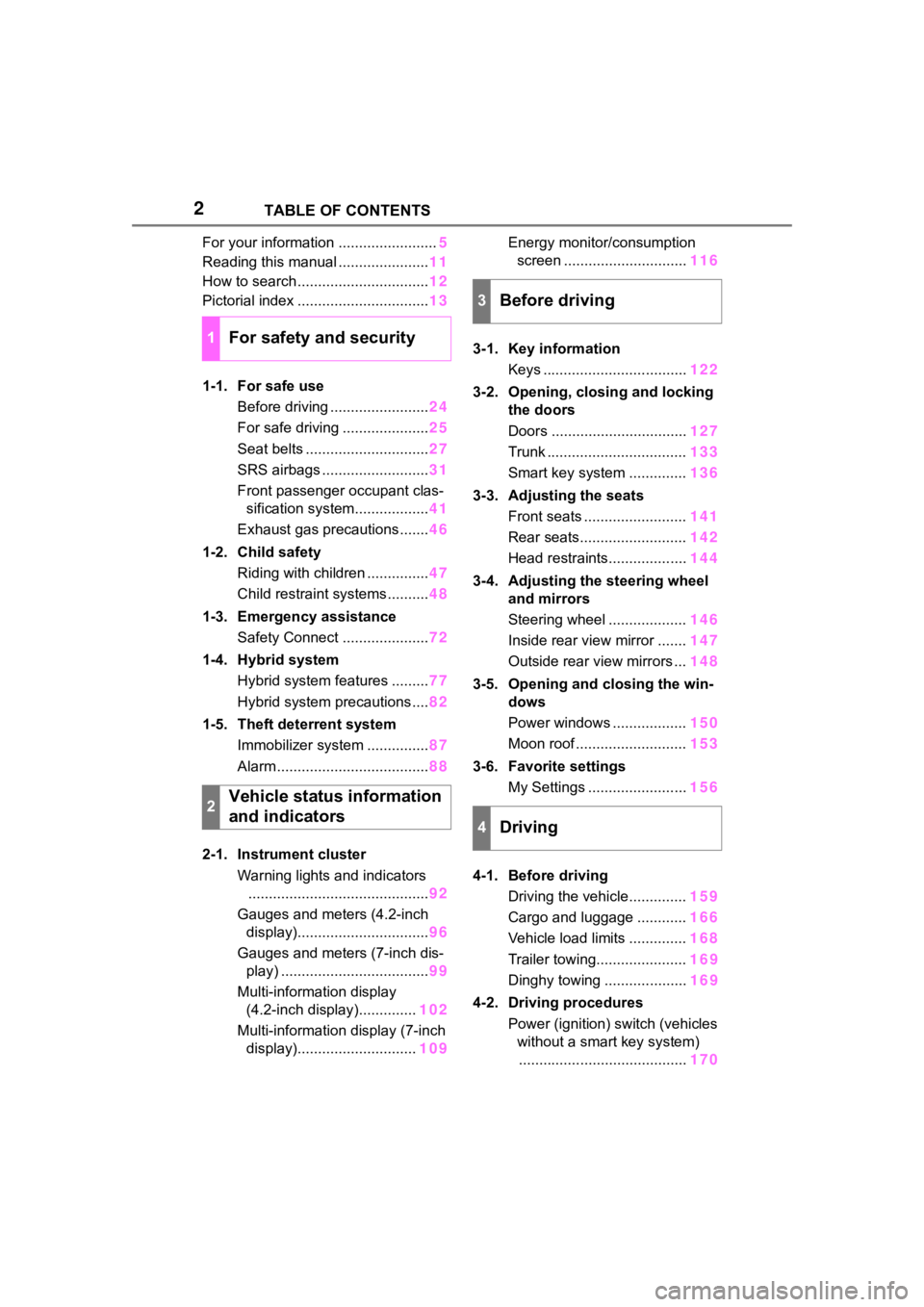
2TABLE OF CONTENTS
For your information ........................5
Reading this manual ...................... 11
How to search ................................ 12
Pictorial index ................................ 13
1-1. For safe use Before driving ........................ 24
For safe driving ..................... 25
Seat belts .............................. 27
SRS airbags .......................... 31
Front passenger occupant clas- sification system.................. 41
Exhaust gas precautions....... 46
1-2. Child safety Riding with children ............... 47
Child restraint systems .......... 48
1-3. Emergency assistance Safety Connect ..................... 72
1-4. Hybrid system Hybrid system features ......... 77
Hybrid system precautions .... 82
1-5. Theft deterrent system Immobilizer system ............... 87
Alarm ..................................... 88
2-1. Instrument cluster Warning lights and indicators............................................ 92
Gauges and meters (4.2-inch display)................................ 96
Gauges and meters (7-inch dis- play) .................................... 99
Multi-information display (4.2-inch display).............. 102
Multi-information display (7-inch display)............................. 109Energy monitor/consumption
screen .............................. 116
3-1. Key information Keys ................................... 122
3-2. Opening, closing and locking the doors
Doors ................................. 127
Trunk .................................. 133
Smart key system .............. 136
3-3. Adjusting the seats Front seats ......................... 141
Rear seats.......................... 142
Head restraints................... 144
3-4. Adjusting the steering wheel and mirrors
Steering wheel ................... 146
Inside rear view mirror ....... 147
Outside rear view mirrors ... 148
3-5. Opening and closing the win- dows
Power windows .................. 150
Moon roof ........................... 153
3-6. Favorite settings My Settings ........................ 156
4-1. Before driving Driving the vehicle.............. 159
Cargo and luggage ............ 166
Vehicle load limits .............. 168
Trailer towing...................... 16
9
Dinghy towing ....................16
9
4-2. Driving procedures Power (ignition) switch (vehicles without a smart key system)......................................... 170
1For safety and security
2Vehicle status information
and indicators
3Before driving
4Driving
Page 157 of 496
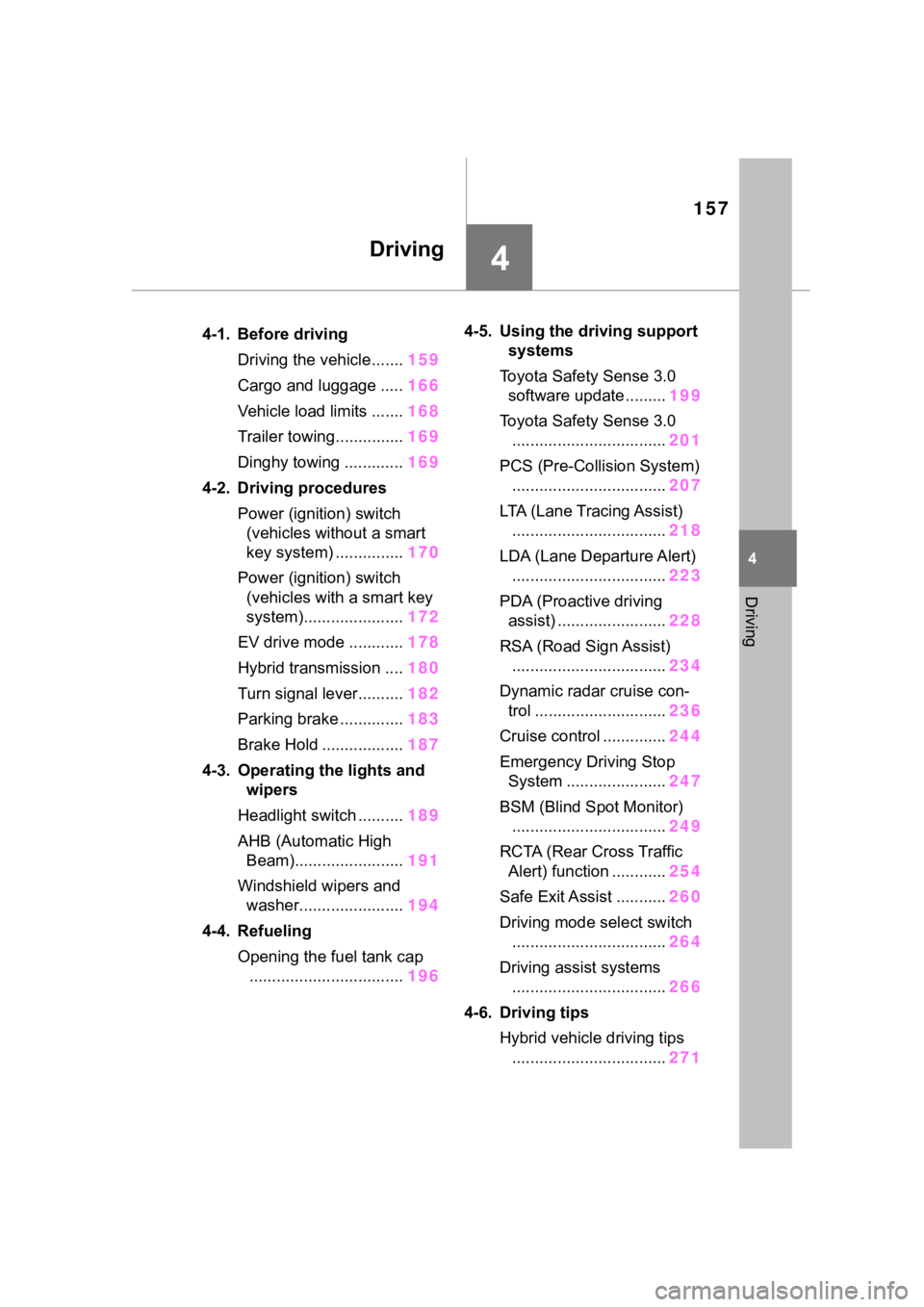
157
4
4
Driving
Driving
.4-1. Before drivingDriving the vehicle....... 159
Cargo and luggage ..... 166
Vehicle load limits ....... 168
Trailer towing............... 169
Dinghy towing ............. 169
4-2. Driving procedures Power (ignition) switch (vehicles without a smart
key system) ............... 170
Power (ignition) switch (vehicles with a smart key
system)...................... 172
EV drive mode ............ 178
Hybrid transmission .... 180
Turn signal lever.......... 182
Parking brake .............. 183
Brake Hold .................. 187
4-3. Operating the lights and wipers
Headlight switch .......... 189
AHB (Automatic High Beam)........................ 191
Windshield wipers and washer....................... 194
4-4. Refueling Opening the fuel tank cap.................................. 1964-5. Using the dr
iving support
systems
Toyota Safety Sense 3.0 software update ......... 199
Toyota Safety Sense 3.0 .................................. 201
PCS (Pre-Collision System) .................................. 207
LTA (Lane Tracing Assist) .................................. 218
LDA (Lane Departure Alert) .................................. 223
PDA (Proactive driving assist) ........................ 228
RSA (Road Sign Assist) .................................. 234
Dynamic radar cruise con- trol ............................. 236
Cruise control .............. 244
Emergency Driving Stop System ...................... 247
BSM (Blind Spot Monitor) .................................. 249
RCTA (Rear Cross Traffic Alert) function ............ 254
Safe Exit Assist ........... 260
Driving mode select switch .................................. 264
Driving assist systems .................................. 266
4-6. Driving tips Hybrid vehicle driving tips.................................. 271
Page 166 of 496
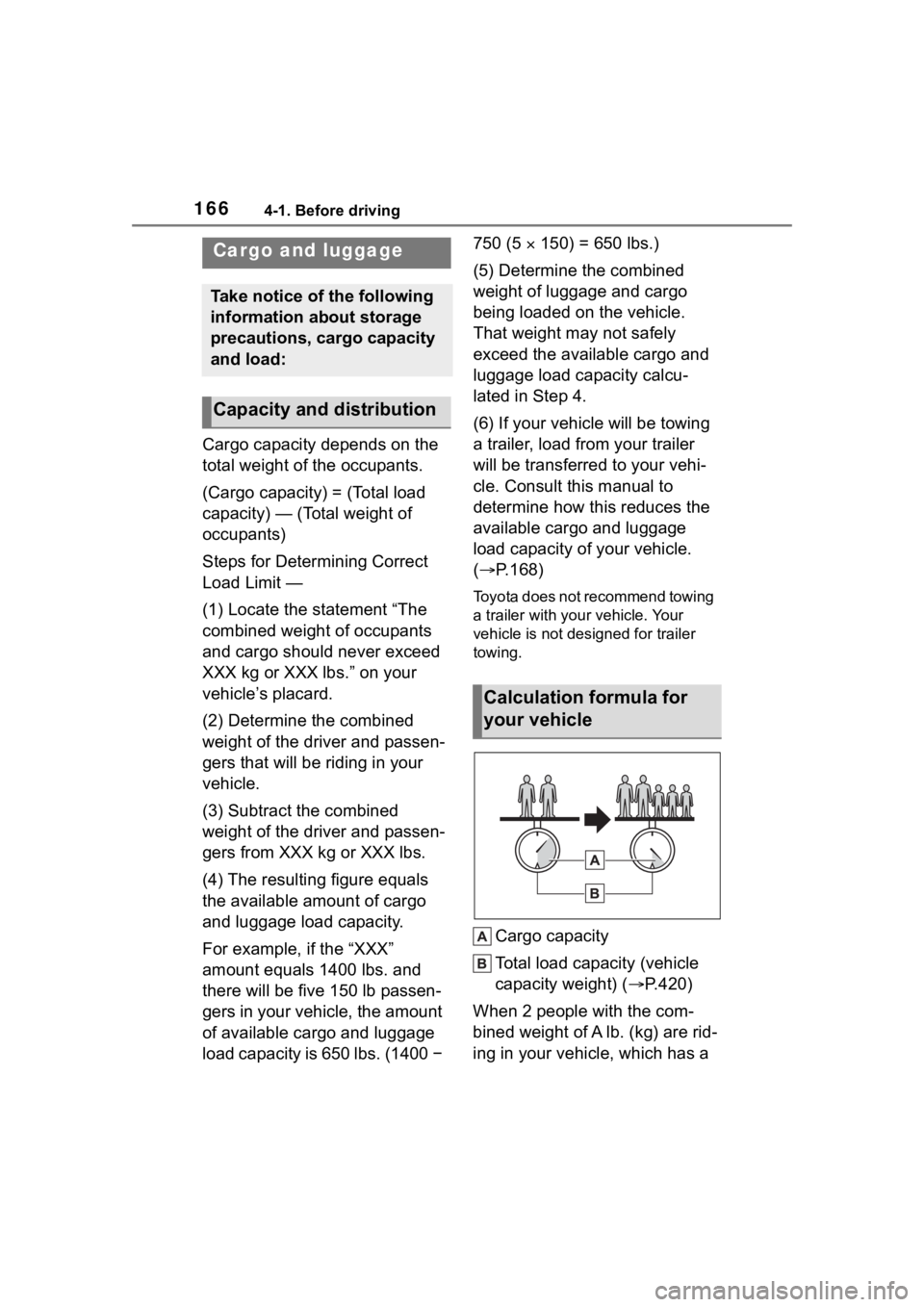
1664-1. Before driving
Cargo capacity depends on the
total weight of the occupants.
(Cargo capacity) = (Total load
capacity) — (Total weight of
occupants)
Steps for Determining Correct
Load Limit —
(1) Locate the statement “The
combined weight of occupants
and cargo should never exceed
XXX kg or XXX lbs.” on your
vehicle’s placard.
(2) Determine the combined
weight of the driver and passen-
gers that will be riding in your
vehicle.
(3) Subtract the combined
weight of the driver and passen-
gers from XXX kg or XXX lbs.
(4) The resulting figure equals
the available amount of cargo
and luggage load capacity.
For example, if the “XXX”
amount equals 1400 lbs. and
there will be five 150 lb passen-
gers in your vehicle, the amount
of available cargo and luggage
load capacity is 650 lbs. (1400 − 750 (5
150) = 650 lbs.)
(5) Determine the combined
weight of luggage and cargo
being loaded on the vehicle.
That weight may not safely
exceed the available cargo and
luggage load capacity calcu-
lated in Step 4.
(6) If your vehicle will be towing
a trailer, load from your trailer
will be transferred to your vehi-
cle. Consult this manual to
determine how this reduces the
available cargo and luggage
load capacity of your vehicle.
( P.168)
Toyota does not recommend towing
a trailer with your vehicle. Your
vehicle is not designed for trailer
towing.
Cargo capacity
Total load capacity (vehicle
capacity weight) ( P.420)
When 2 people with the com-
bined weight of A lb. (kg) are rid-
ing in your vehicle, which has a
Cargo and luggage
Take notice of the following
information about storage
precautions, cargo capacity
and load:
Capacity and distribution
Calculation formula for
your vehicle
Page 168 of 496
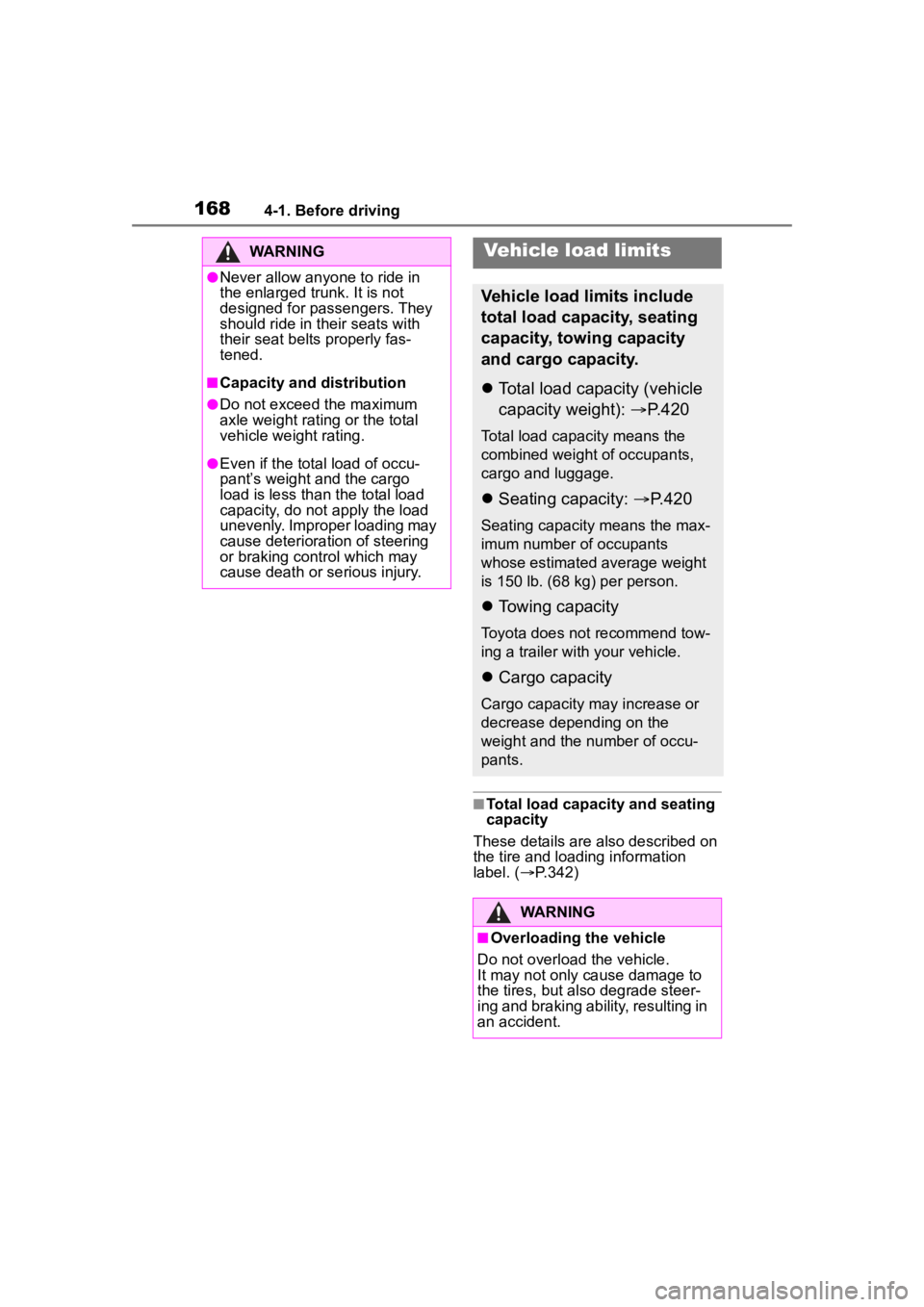
1684-1. Before driving
■Total load capacity and seating
capacity
These details are also described on
the tire and loading information
label. ( P.342)
WARNING
●Never allow anyone to ride in
the enlarged trunk. It is not
designed for passengers. They
should ride in their seats with
their seat belts properly fas-
tened.
■Capacity and distribution
●Do not exceed the maximum
axle weight rating or the total
vehicle weight rating.
●Even if the tota l load of occu-
pant’s weight and the cargo
load is less than the total load
capacity, do not apply the load
unevenly. Improper loading may
cause deteriorat ion of steering
or braking control which may
cause death or serious injury.
Vehicle load limits
Vehicle load limits include
total load capacity, seating
capacity, towing capacity
and cargo capacity.
Total load capacity (vehicle
capacity weight): P.420
Total load capacity means the
combined weight of occupants,
cargo and luggage.
Seating capacity: P.420
Seating capacity means the max-
imum number of occupants
whose estimated average weight
is 150 lb. (68 k g) per person.
Towing capacity
Toyota does not recommend tow-
ing a trailer with your vehicle.
Cargo capacity
Cargo capacity may increase or
decrease depending on the
weight and the number of occu-
pants.
WARNING
■Overloading the vehicle
Do not overload the vehicle.
It may not only cause damage to
the tires, but also degrade steer-
ing and braking ability, resulting in
an accident.
Page 169 of 496
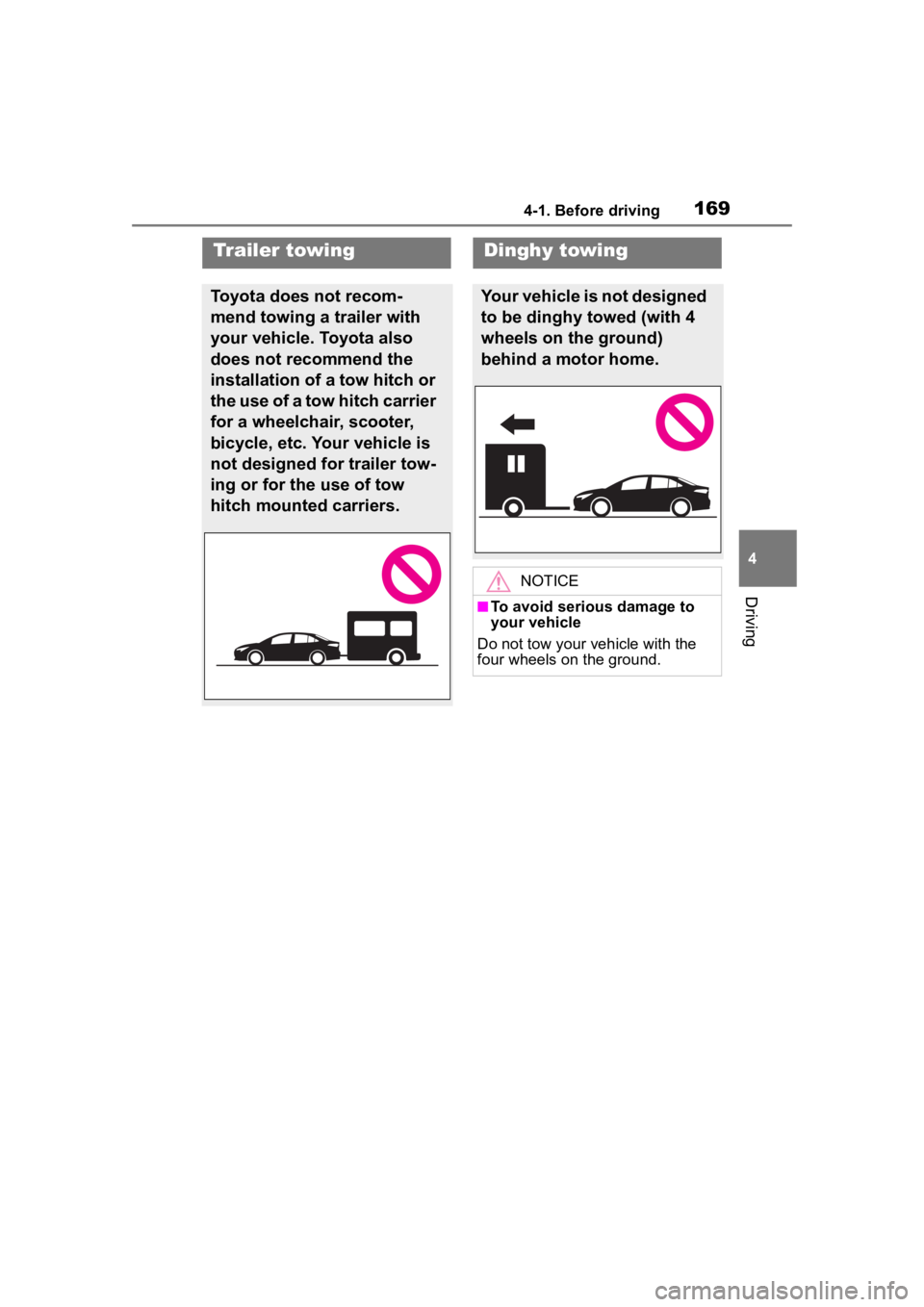
1694-1. Before driving
4
Driving
Trailer towing
Toyota does not recom-
mend towing a trailer with
your vehicle. Toyota also
does not recommend the
installation of a tow hitch or
the use of a tow hitch carrier
for a wheelchair, scooter,
bicycle, etc. Your vehicle is
not designed for trailer tow-
ing or for the use of tow
hitch mounted carriers.
Dinghy towing
Your vehicle is not designed
to be dinghy towed (with 4
wheels on the ground)
behind a motor home.
NOTICE
■To avoid serious damage to
your vehicle
Do not tow your vehicle with the
four wheels on the ground.
Page 205 of 496

2054-5. Using the driving support systems
4
Driving
■Situations in which the sensors
may not operate properly
●When the height or inclination of
the vehicle has been changed due
to modifications
●When the windshield is dirty,
fogged up, cracked or damaged
●When the ambient temperature is
high or low
●When mud, water, snow, dead
insects, foreign matter, etc., is
attached to the front of the sensor
●When in inclement weather such
as heavy rain, fog, snow, or a
sandstorm
●When water, snow, dust, etc. is
thrown up in front of the vehicle, or
when driving through mist or
smoke
●When the headlig hts are not illu-
minated while driving in the dark,
such as at night o r when in a tun-
nel
●When the lens of a headlight is
dirty and illumination is weak
●When the headlights are mis-
aligned
●When a headlight is malfunction-
ing
●When the headlights of another
vehicle, sunlight, or reflected light
shines directly into the front cam-
era
●When the brightness of the sur-
rounding area changes suddenly
●When driving near a TV tower,
broadcasting station, electric
power plant, radar equipped vehi-
cles, etc., or other location where
strong radio waves or electrical
noise may be present
●When a wiper blade is blocking
the front camera
●When in a location or near objects
which strongly reflect radio waves,
such as the following:
• Tunnels
• Truss bridges
• Gravel roads
• Rutted, snow-covered roads
• Walls
• Large trucks
• Manhole covers
• Guardrail
• Metal plates
●When near a step or protrusion
●When a detectable vehicle is nar-
row, such as a small mobility vehi-
cle
●When a detectable vehicle has a
small front or rear end, such as an
unloaded truck
●When a detectable vehicle has a
low front or rear end, such as a
low bed trailer
●When a detectable vehicle has
extremely high ground clearance
WARNING
■Front camera installation area
on the windshield
If the system determines that the
windshield may be fogged up, it
will automatically operate the
heater to defog the part of the
windshield around the front cam-
era. When cleaning, etc., be care-
ful not to touch the area around
the front camera until the wind-
shield has cooled sufficiently, as
touching it may cause burns.
Page 258 of 496
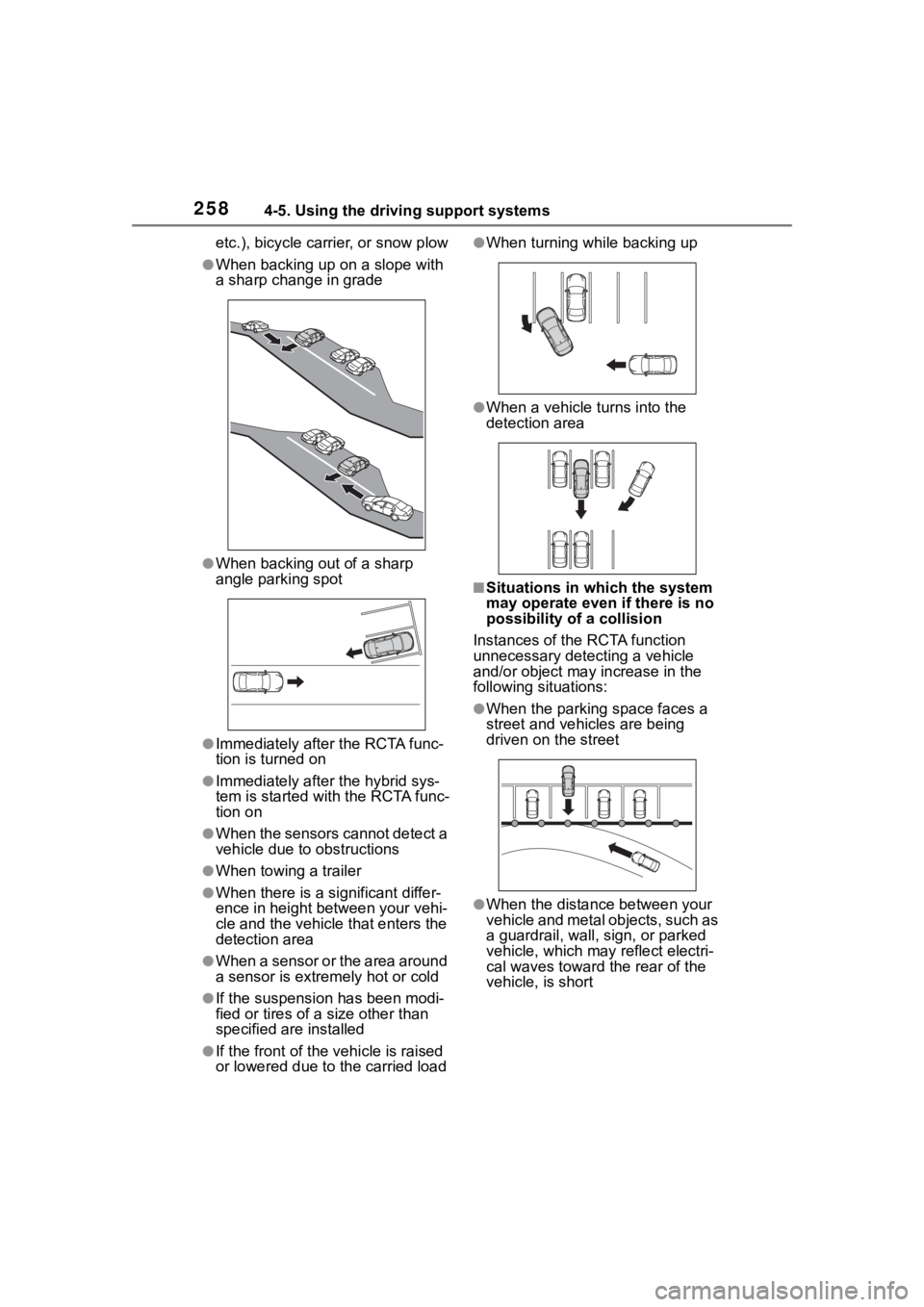
2584-5. Using the driving support systems
etc.), bicycle carrier, or snow plow
●When backing up on a slope with
a sharp change in grade
●When backing out of a sharp
angle parking spot
●Immediately after the RCTA func-
tion is turned on
●Immediately after the hybrid sys-
tem is started with the RCTA func-
tion on
●When the sensors cannot detect a
vehicle due to obstructions
●When towing a trailer
●When there is a significant differ-
ence in height between your vehi-
cle and the vehicle that enters the
detection area
●When a sensor or the area around
a sensor is extremely hot or cold
●If the suspension has been modi-
fied or tires of a size other than
specified are installed
●If the front of the vehicle is raised
or lowered due to the carried load
●When turning while backing up
●When a vehicle tu rns into the
detection area
■Situations in which the system
may operate even if there is no
possibility of a collision
Instances of the RCTA function
unnecessary detec ting a vehicle
and/or object may increase in the
following situations:
●When the parking space faces a
street and vehicles are being
driven on the street
●When the distance between your
vehicle and metal objects, such as
a guardrail, wall, sign, or parked
vehicle, which may reflect electri-
cal waves toward the rear of the
vehicle, is short
Page 477 of 496

477Alphabetical Index
Replacing ............................. 398
Rotating tires ........................ 327
Size ...................................... 426
Snow tires ............................ 273
Spare tire.............................. 398
Tire pressure warning system........................................... 328
Warning light ........................ 376
Tools ................................ 388, 399
Top tether strap ........................ 68
Total load capacity ................. 420
To w i n g Dinghy towing....................... 169
Emergency towing................ 366
Towing eyelet ....................... 369
Trailer towing ........................ 169
Toyota Safety Sense AHB (Automatic High Beam) 191
Cruise control ....................... 244
Dynamic radar cruise control 236
Emergency Driving Stop System........................................... 247
LDA (Lane Departure Alert) .. 223
LTA (Lane Tracing Assist) ..... 218
PCS (Pre-Collision System) . 207
RSA (Road Sign Assist) ....... 234
Toyota Safety Sense 3.0[Toyota Safety Sense 3.0]PDA (Proactive driving assist) [PDA (Proactive driving assist)]........................................... 228
TRAC (Traction Control) ........ 266
Traction battery (hybrid battery) Hybrid battery (traction battery) air vents................................ 85
Location.................................. 82
Specification ......................... 422
Warning message .................. 86
Traction Control (TRAC) ........ 266
Traction motor (electric motor)77
Trailer towing .......................... 169 Transmission
Driving mode select switch ...264
Hybrid transmission ..............180
If th e s hif t le ver ca n no t b e s hif te d from P .................................181
Trip meters ........................97, 101
Trunk ........................................133 Internal trunk rele ase lever ...135
Smart key system .................134
Trunk light .............................135
Trunk opener ........................134
Wireless remote control........134
Trunk light ...............................135 Wattage ................................428
Turn signal lights Replacing light bulbs ............357
Turn signal lever ...................182
Wattage ................................428
U
USB charging port ..................291
V
Vanity lights ............................298Wattage ................................428
Vanity mirrors .........................298
Vehicle data recording ...............6
Vehicle identification number420
Vehicle information display .107, 11 3
Vehicle Stability Control (VSC) ...............................................266
VSC (Vehicle Stability Control) ...............................................266
W
Warning buzzers ABS ......................................374
Airbags .................................374
Approach warning ................243